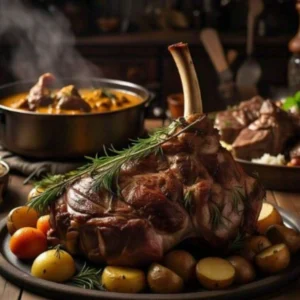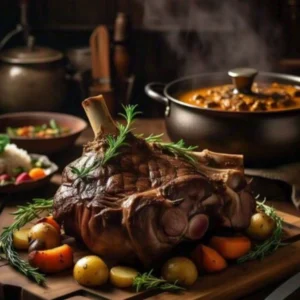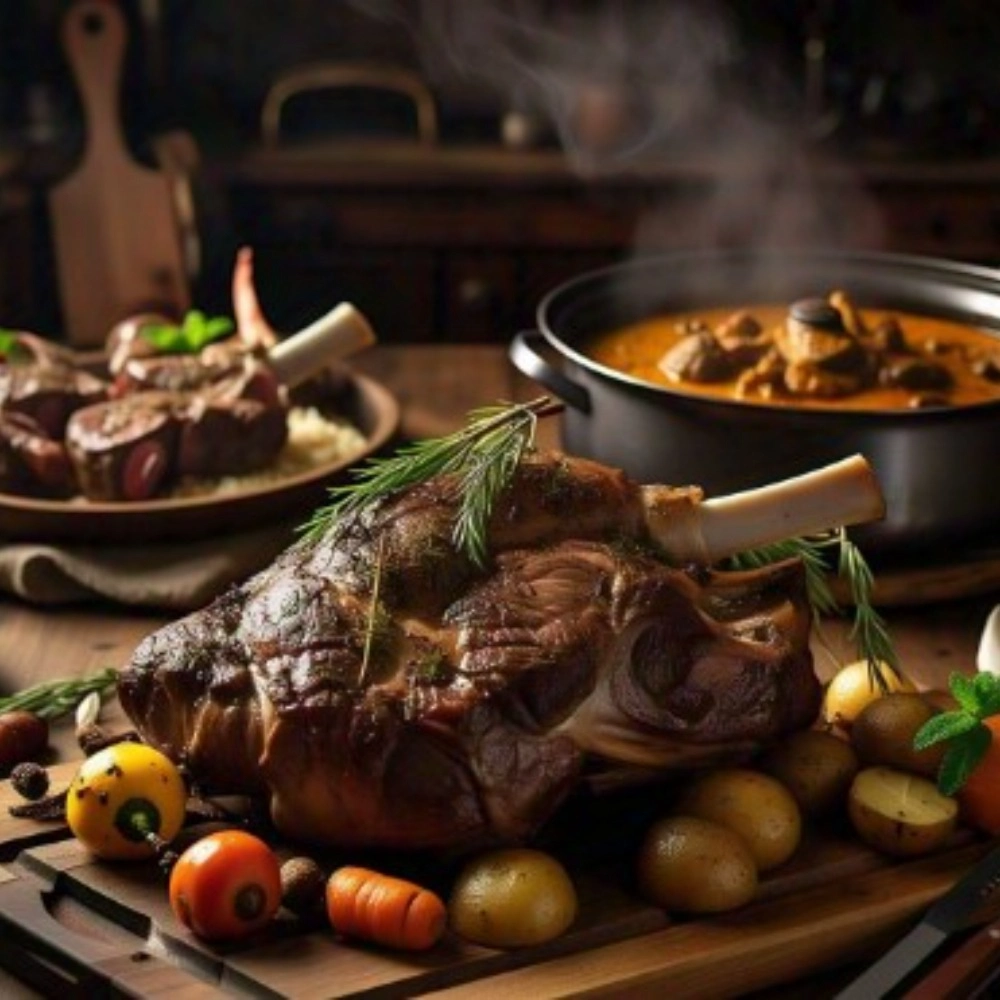Mastering the Art of Lamb and Mutton Recipe
Once you begin the expedition to cook the tastiest of lamb and the richest of mutton dishes you are going to scale new heights of cooking. These juicy meats have so much to give and they can be roasted and curried for example.

Read on and learn the finer points in dealing with lamb and mutton, whether you’re just a professional cook or a weekend sentry in the kitchen. Read on to learn from professional advice and traditional and modern methods on how to deal with these flexible meats.
Fasten your seat belts, and prepare to stun your guests while you also get to master how to prepare palatable lamb and mutton dishes. I have 20 years of experience in cooking. So you can trust me.
Understanding the Difference Between Lamb and Mutton
Age and Flavor Profile
When preparing sheep meat, there is an important difference between lamb and mutton that one needs to know. The major difference can be summed up in the fact that one produces meat from animals that are older than the other.
Lamb is the meat from sheep that are below one year of age and mutton is derived from the actual sheep that are old or more than one year. This demands that the age of these animals should vary greatly to affect the taste and texture of muscle meat.
Lamb is characterized by its fine but firm gamy and has a subtle, elegant taste. Some refer to its having a light, grassy flavor and being comparatively less in taste than beef. On the other hand, mutton, the meat from mature animals, tastes rather different than from a sheep, and some people refer to its taste as ‘gamey’. Compared to any other part, its texture is firmer and chewier because the animal was older.
Culinary Applications
These properties make the differences more apparent in terms of application in the kitchen, between lamb and mutton. Due to its softness and relatively light taste, lamb is suitable for many kinds of preparation, which range from Mediterranean to Middle Eastern.
It is specifically suitable for grilling, roasting as well as browning or braising. Mutton, has a much stronger flavor than other types of meat, which is why it is mostly used for stews, curries, or any meals which are cooked long and where the strong taste of the meat can be softened by spices and long cooking time. Aware of these distinctions one can decide on the kind of meat that will brighten the taste and quality of the dish.
Selecting the Best Cuts of Lamb and Mutton
Selecting the right cut of either lamb or mutton while preparing a scrumptious dish of either forms the backbone of the whole process. The choice made here determines the outcome of the look that is achieved; therefore, the options open must be familiar.

Prime Cuts for Roasting
When it comes to roasting, the best choice of lamb is leg, shoulder, or rack of lamb. These cuts are tender and a little marbled for that slow cooking technique. The leg is a leaner cut in comparison to the shoulder, and therefore less tender and juicy in comparison to the marbling in the shoulder. A rack of lamb, regarded as the chieftain’s food, is fantastic for festive meals.
Cuts for Quick Cooking
When you are in a hurry, there are loin chops, rib chops, and sirloin. These cuts can well be grilled, pan-seared, or even broiled to get a crispy end product. They take a short time to cook and are still tender if undercooked or not overcooked. This cut particularly loin chops is known for being tender and has a comparatively less gamey taste.
Budget-Friendly Options
Do not rule out cheaper cuts such as shank, neck, or breast. These leaner cuts are excellent when slow cooked, to become tender and succulent when combined with an intense meaty taste. They are ideal for thick-based eyed stews, curries, or slow-cooking tagines.
Remember, freshness is key. Select fresh meat by its fresh pink colored and non-soft texture depending on the specific cut of meat. This guide to cuts of lamb and mutton and their preparation will help you get a good start in the cooking of these meats.
Mastering the Art of Lamb and Mutton Preparation
Understanding the Cuts
Knowledge of your cuts always plays a very important role when preparing lamb and mutton. Instead, the image of meat pieces from tenderloin to the shoulder is created with certain different characteristics in mind.
For example, the leg is well suited for roasting, and the rib chops are better when grilled. To make it easier for you to understand the differences among the various cuts, this article will explain which cut is best for your dish and which cooking method to use.
Seasoning and Marinating
Therefore, the major difference between lamb and mutton and the optimal utilization of both products fully is seasoning. That is why all these meats are highly recommended to be cooked with robust herbs which include; rosemary, thyme, and mint.
If you want to continue cooking on the Mediterranean flair, rubbing garlic and lemon zest as well as oregano would help. Soaking is also useful to improve tastes and textures and to soften up the spaces between muscle fibers.
One of the best marinades is yogurt because the yogurt adds the taste of freshness to the meat and tenderizes it at the same time.
Cooking Techniques
Pleasing results when cooking lamb and mutton depend on the various culinary methods being practiced. Most slow roasting is perfect when dealing with large pieces of meat because the piece tenderizes and accumulates lots of flavors as it cooks.
For convenience, pan-searing chops to develop a great surface while still being tender inside is a great idea. Bear in mind though that lamb is more delicious if it is pink in the middle cutting it to medium at most while mutton is tougher therefore it requires longer cooking time in the oven.
Delicious Lamb and Mutton Recipe Ideas
Classic Roast Lamb
Stand your cooking dishes on a higher level through this simple roast lamb recipe. First marinate a leg of lamb with garlic, rosemary, and olive oil. Bake it nicely, until it garners a brown crust on the outside, while the inside will be soft and juicy. It is best served with roasted vegetables for a well-rounded meal that will be enjoyed by a lot of people.

Spicy Mutton Curry
For those who like it hot try mutton curry spiced. Well with this recipe you simply marinate the cubed mutton with yogurt and spices and slowly cook in the tomato-based gravy with the addition of mild onions, ginger, and garlic.
Slow cooking makes the meat to be soft and ideally, you just need to pull it off the bone. Serve as a side to saucy basmati rice or complement it with warm naan bread for supper.
Grilled Lamb Chops
The grilled lamb chops will suit the summer barbecues as they will be loved by many people. Prepare the chops and toss them in a marinade of juice of one lemon, one tablespoon of olive oil, and herbs. It is best to grill them to medium-rare that way the muscles have the right tenderness and full flavor.
The following feeding recommended will be sumptuous with a fresh Greek salad or grilled vegetables making it equally gratifying without feeling weighed down as one might with plain chops It’s a lot lighter than most preparations of boiled mutton chops.
Serving and Enjoying Your Lamb and Mutton Dishes
Presentation Matters
It is always important when preparing your lamb or mutton and it can take your tasty dish to the next level. Stack your meat attractively on warm plates to serve in order to keep it warm and attractive. Add some chopped parsley, thyme, or basil on top of the potatoes which gives some color and the right scent.
If you want to give your country-style shape to the dishes, transfer the food in the cooking vessel right to the dining area.
Pairing Perfection
Some side dishes’ additions can improve your lambs or mutton. Accompanying the roast you can choose European and familiar tastes such as roasted potatoes, mint sauce, or a great Greek salad. Some variants of the traditional classic include quinoa tabbouleh and or grilled vegetables.
When it comes to wines there is nothing like a full-bodied red wine, for example, Cabernet Sauvignon or Syraz to complement the taste of lamb and mutton.
Savoring the Experience
This wonderful piece of advice from the experts means that you should use all five of your senses when enjoying your lamb or mutton dish. Take some time to smell the food before you even put it into your mouth.
To fully appreciate the food’s different tastes and Speck and toil, take your time to chew. As you will note, both lamb and mutton are some of the best foods that should be enjoyed in good company; you can organize a dinner party to feed people and share food preparation with friends and other relatives.
Conclusion
Before you go ahead and cook using lamb and mutton, I want you to know that it takes time and effort before you can master how to cook these proteins. Increase your knowledge of the distinctive taste and texture of those meats and you’ll be able to cook meals that will set your taste buds alive.
Whether you’re having company over for a leg of lamb or cooking mutton curry on a cold rainy day, everything you need to know is right here in this article. Spare time coupled with keenness and understanding and you will soon be flexing your culinary muscles in presenting delicious lamb and mutton recipes.
Therefore put on the apron, hone up your knives, and bring out your best cooking techniques through these convenient and tasty meats.
Frequently Asked Questions (FAQs)
What’s the difference between lamb and mutton?
Lamb is meat from sheep that are less than one year old and mutton is that which is obtained from adult sheep. Lamb is soft and has the slightest possible taste than mutton which has the taste of a mature animal and also has harder tissues. In general, lamb is more costly than beef and is usually more popular in Western dishes.
How do I know when the lamb is cooked properly?
For lamb that is served medium rare the internal temperature must be taken to be 145°F (63°C). Instead of checking the feel of the meat, use a meat thermometer. It should also be reddish in the middle, though not bloody.
It should also be allowed to stand for between 3-5 minutes to allow the juices to break and be reabsorbed into the chatting. For well-done lamb, the internal temperature should be around 71 degrees Celsius but it shouldn’t be overdone because the meat gets really hard.
What are some popular lamb cuts and their best cooking methods?
-
Leg of lamb: Ideal for roasting or grilling
-
Lamb chops: Perfect for pan-frying or grilling
-
Shoulder: Great for slow-cooking or braising
-
Rack of lamb: Excellent for roasting or grilling
Each cut has its own musculature and fat patterns so adapt cooking times and techniques to suit the cut of meat.
About Us:
Best chocolate chip cookies in Air fryer
Simple Crab Cake Recipe You Need to Try

Hello! My name is Wahab Khan. I, having over 20 years of culinary experience, bring both my knowledge and passion to each Recipe featured here. I create delicious, accessible dishes for beginners and seasoned cooks alike, and think that good food can help connect people. My recipes combine timeless techniques with stellar new spins, allowing readers to master the everyday flavors of the World.
